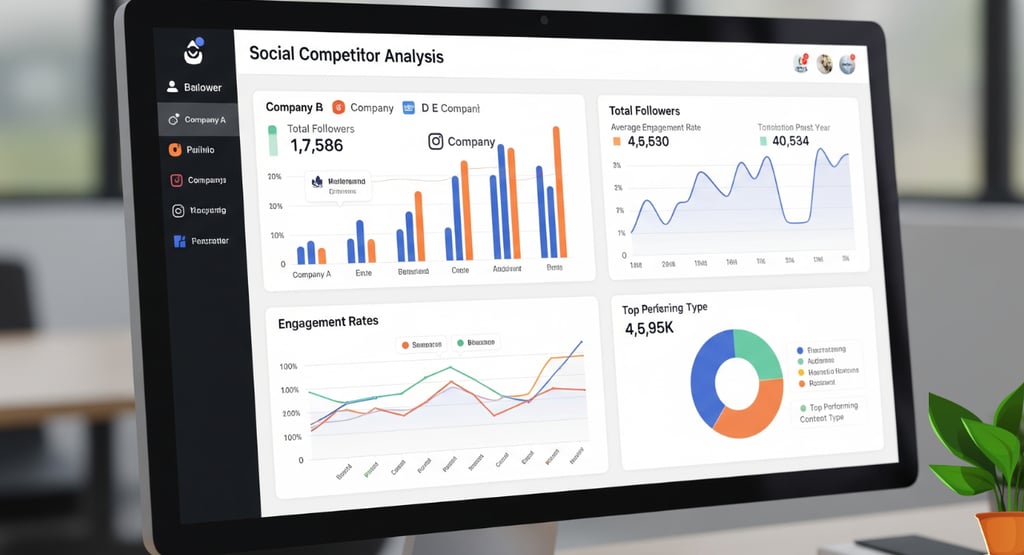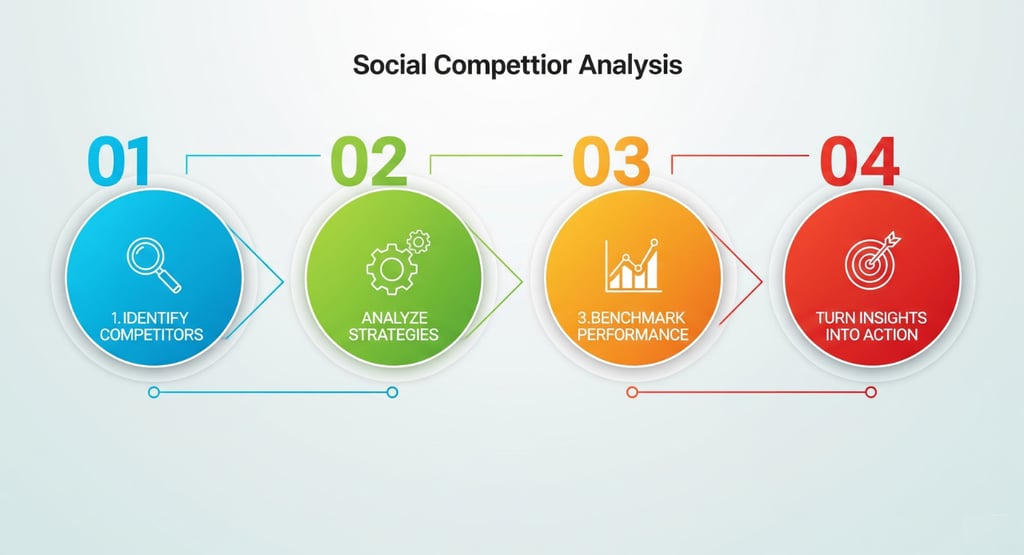How to perform a social media competitor analysis: A complete guide
Master social media competitor analysis with our complete guide. Learn how to benchmark performance, find content gaps, and optimize your strategy to outperform your rivals and win on social media.
Eddy Enoma
8/11/202510 min read
Everything you need to know to analyze rivals, optimize your strategy, and win on social media.
With social media now the number one channel for connecting with customers, businesses that master social media competitor analysis gain a significant advantage in audience engagement, content strategy, and market positioning. A recent study highlights that over 70% of marketers view it as their most effective channel, yet many are still navigating it without a complete map. While you’re busy building your brand and crafting content, your competitors are doing the same, and some might be doing it better. The real question isn’t whether you should be watching them, but how to do it effectively and consistently to stay ahead.
A strong social media presence is no longer just a nice-to-have; it’s a strategic necessity. To succeed, you must move beyond simply posting and hoping for the best. Understanding the competitive landscape provides you with a crucial edge, giving you insights into what resonates with your shared audience, what content formats are winning, and what gaps exist in the market. This isn’t about copying what others do; it’s about learning from their successes and failures to inform your own unique strategy.
This comprehensive guide is designed to provide you with a clear, step-by-step framework for performing a social media competitor analysis. We’ll show you how to identify the right competitors, systematically analyze their strategies, and, most importantly, turn that intelligence into actionable opportunities for your own brand. By the end, you’ll know how to move from a reactive to a proactive social media approach, ensuring your efforts are not only visible but also impactful.
What is a Social Media Competitor Analysis?
A social media competitor analysis is the systematic process of researching and evaluating your competitors’ social media strategies, performance, and tactics to gain insights that improve your own social media marketing efforts. This analysis goes beyond simply following your competitors’ accounts. It involves strategic intelligence gathering, performance benchmarking, and opportunity identification.
Strategic intelligence gathering: This means understanding how competitors position themselves across different platforms. Analyze their content strategies, posting frequency, and engagement tactics. Identify their target audience and how they interact with followers, and evaluate their social media advertising approaches.
Performance benchmarking: Compare engagement rates, follower growth, and reach metrics to your own. Analyze which content types generate the most interaction and understand seasonal trends and campaign performance. This also includes measuring your share of voice within your industry.
Opportunity identification: Find content gaps your competitors haven’t addressed. Discover underutilized platforms or audience segments, and identify trending topics and hashtags before they peak. Recognize weaknesses in competitor strategies you can exploit.
Unlike traditional market research, social media competitor analysis provides real-time insights into competitor activities. You can see immediately when a competitor launches a new campaign, changes their messaging, or experiences a viral moment, allowing you to respond quickly and strategically. The goal isn’t to copy your competitors, but to understand the competitor landscape well enough to differentiate your brand effectively while learning from proven strategies that work in your industry.
The Benefits of Running a Competitor Analysis on Social Media
Conducting regular social media competitor analysis delivers significant advantages that directly impact your marketing performance and business growth. Understanding what your competitors are doing right (and wrong) on social media provides invaluable insights that can change your own strategy from reactive to proactive. The strategic approach helps you avoid costly mistakes while identifying proven tactics that work in your industry. The key is knowing how to extract actionable insights from competitor data and apply them to your unique brand positioning.
Identify content gaps and opportunities. One of the most valuable outcomes of social media competitor analysis is discovering what your competitors aren’t doing well or aren’t doing at all. These gaps represent golden opportunities for your brand to establish thought leadership and capture audience attention in underserved areas. By analyzing what your competitors post, you can identify topics, formats, and approaches they’re missing. Any tool that allows you to monitor your brand and others can also be used to track competitors and gain invaluable insights into the competition. You can spot emerging trends and topics before they become saturated, giving you a first-mover advantage. A tool like Surfer SEO can help you uncover content gaps that are popular with your target audience, not just on social media but also on search engines, helping you create a more cohesive content strategy.
Understand audience preferences and behavior. Your competitors are targeting the exact audience you want to reach, making their social media activities a valuable window into what resonates with your potential customers. By analyzing how audiences interact with competitor content, you gain insights that would otherwise require extensive market research. Competitor analysis reveals what resonates with your shared target audience. You can see which posts generate the most engagement, what time followers are most active, and which messaging approaches drive responses.
Benchmark your performance against industry leaders. Without a competitor context, your social media metrics exist in a vacuum. Understanding how you perform relative to competitors and industry standards provides the perspective needed to set realistic goals and measure true success. Your social media metrics only have meaning when compared to industry standards and the performance of your competitors. Competitor analysis provides the necessary context to evaluate your success accurately.
Discover trending topics and hashtags. Staying ahead of trends is crucial for social media success, but manually tracking every emerging topic is impossible. Competitor analysis provides a systematic way to identify what’s gaining traction in your industry before it becomes mainstream. Identify which hashtags competitors use successfully and discover new hashtag opportunities that could expand your reach. Understanding seasonal trends, industry events, and promotional periods that competitors capitalize on helps you plan your content calendar strategically.
Improve your content strategy and posting schedule. Timing and consistency are critical factors in social media success. By analyzing when competitors post and how their audiences respond, you can optimize your posting strategy for maximum impact. A study by Databox found that businesses that post consistently on social media see up to a 200% increase in engagement. Analyze when competitors post and when their content receives the most engagement to optimize your posting schedule. Determine the optimal ratio of promotional, educational, and entertaining content that works best in your industry.
Develop a competitive advantage. The ultimate goal of competitor analysis is to develop sustainable advantages that set your brand apart from the competition. It involves both learning from competitor successes and identifying ways to differentiate your approach. Understanding competitor strategies enables you to identify effective ways to differentiate your brand and messaging approach. You can discover areas where competitors underperform or have poor customer sentiment, creating opportunities for your brand to excel. The businesses that thrive on social media aren’t just creating good content; they’re making strategic content informed by competitive intelligence. Regular competitor analysis ensures your social media efforts are informed, strategic, and positioned for maximum impact.
How to do a Social Media Competitor Analysis in 4 Steps
Effective social media competitor analysis requires a systematic approach. This proven 4-step framework ensures you gather the right intelligence and turn it into actionable strategies that drive real business results.
Step 1: Identify your social media competitors. The foundation of practical competitor analysis lies in identifying the right competitors to monitor. It goes beyond obvious business competitors to include accounts that compete for your target audience’s attention. A good place to start is with a search on Google for your product category, such as “fitness gear” or “athletic wear.” Analyze the top results and visit those competitor websites to study their offerings. Then, examine their social media presence to understand their content strategy. You can also use a tool like Predis AI to monitor fitness-related conversations on social platforms and identify competitors through organic mentions and discussions. Track hashtags, comments, and user-generated content to discover both direct and indirect competitors.
Step 2: Analyze competitor social media strategies. Once you’ve identified your key competitors, thoroughly analyze their social media strategies across all platforms where they’re active.
Content strategy analysis: Look at the types of content they post (visual content, videos, text-based posts, user-generated content) and their content themes (educational, promotional, entertainment, community-focused). Pay attention to their posting patterns, including frequency, timing, and consistency across platforms.
Engagement strategy evaluation: Observe how they manage their community. What is their response time and style? How do they use social listening, hashtag usage, and mention handling? Also, look for influencer collaborations and cross-platform promotion strategies.
Step 3: Benchmark performance metrics. Quantitative analysis provides the objective data needed to understand competitor performance and identify opportunities for improvement.
Key metrics to track: Monitor audience metrics such as follower growth rate and audience quality. Look at engagement metrics like overall engagement rate and engagement by content type. Evaluate content performance by identifying top-performing posts and the impact of posting frequency. Use tools like ContentStudio to gather comprehensive competitor intelligence, including benchmarking your performance against multiple competitors simultaneously.
Step 4: Turn insights into action. The final step transforms competitor intelligence into strategic advantages through systematic implementation and continuous optimization.
Strategic planning: Conduct a SWOT analysis to identify strengths, weaknesses, opportunities, and threats. Plan your content based on competitor insights and develop a content calendar. Enhance your engagement strategy to build stronger audience relationships, and regularly monitor performance to adjust your strategy. You can use a tool like Taskade AI to help you turn competitor insights into an actionable project plan.
5 Top Social Media Competitor Analysis Tools
The right tools can transform time-consuming manual competitor research into streamlined, automated intelligence gathering. Here are five top social media competitor analysis tools that deliver actionable insights.
1. ContentStudio: All-in-one social media management with competitor intelligence. ContentStudio stands out as a comprehensive social media management platform that integrates robust competitor analysis with content creation, scheduling, and analytics. It provides a unified workspace where you can monitor competitors, create content, and manage your social media presence simultaneously.
Key features: Multi-platform competitor monitoring on Facebook and Instagram, content performance analysis to identify successful content patterns, and competitor benchmarking to compare your performance. It also offers hashtag performance analytics and growth tracking. Try ContentStudio for FREE to see how it can simplify your social media management.
2. Ahrefs: SEO-focused competitor analysis. Ahrefs is primarily known as an SEO powerhouse, but its social media capabilities are valuable for understanding how competitor content performs across both search and social channels. The platform excels at showing the intersection between SEO and social media success, helping you create content that performs well in both areas.
Key features: Content performance analysis across social platforms and search results, backlink analysis, and keyword research. It helps you identify content gaps for both SEO and social opportunities.
3. Mention: Comprehensive social listening. Mention provides real-time social media monitoring that goes beyond basic competitor tracking to offer comprehensive brand mention analysis across the entire web. The platform excels at tracking conversations about your competitors and identifying sentiment trends that can inform your strategy.
Key features: Real-time competitor mention tracking, web monitoring beyond social media (including blogs and forums), and sentiment analysis. It also offers influencer identification and competitor benchmarking tools.
4. Socialbakers (Now Emplifi): Enterprise social analytics. Socialbakers, now part of Emplifi, offers enterprise-grade social media analytics with robust competitor analysis features. The platform provides in-depth insights into competitor performance across multiple social channels, featuring advanced benchmarking capabilities.
Key features: Multi-platform competitor performance tracking, industry benchmarking, content performance analysis, and audience demographic insights. It’s best for large enterprises and agencies that require sophisticated analytics.
5. Keyhole: Hashtag and campaign analysis. Keyhole specializes in hashtag tracking and campaign analysis, making it an ideal tool for businesses that want to understand how competitors utilize hashtags and participate in trending conversations. The platform offers unique insights into hashtag performance and the effectiveness of social media campaigns.
Key features: Hashtag performance tracking, campaign monitoring, and real-time social media tracking. It also provides influencer identification and historical hashtag data analysis.
FAQ’s
How often should I perform a social media competitor analysis? You should conduct a weekly competitor check, a comprehensive analysis monthly, and a strategic review quarterly. Set up automated monitoring for real-time insights, but dedicate time for deep analysis at least once per month to stay ahead of competitor changes and market trends.
Which social media platforms should I analyze for competitors? Focus on platforms where your target audience is most active and where your competitors have a strong presence. This typically includes Facebook, Instagram, Twitter, LinkedIn, and TikTok. However, also consider YouTube, Pinterest, and emerging platforms depending on your industry and audience demographics.
How many competitors should I analyze? Monitor 5–10 competitors regularly, with 3–5 receiving deep daily analysis. Include both direct competitors (similar products/services) and indirect competitors (targeting the same audience). This provides comprehensive insights without overwhelming your analysis process.
Is it legal to analyze competitors’ social media activities? Yes, analyzing publicly available social media content is completely legal. However, you should never create fake accounts, use automated bots that violate platform terms, or attempt to access private competitor information. Stick to publicly available data and respect platform guidelines.
Can small businesses benefit from social media competitor analysis? Absolutely! Small businesses can gain significant advantages from competitor analysis by identifying market gaps, understanding what content resonates with their target audience, optimizing limited resources, and discovering cost-effective strategies that work in their industry without the trial-and-error expense.
What’s the difference between social media competitor analysis and market research? Social media competitor analysis specifically focuses on competitors’ social media strategies, content, and performance. Market research is broader, examining overall industry trends, customer behavior, and market conditions. Competitor analysis is a subset of market research focused on social media channels.
Conclusion
Social media competitor analysis is no longer optional. It’s a strategic necessity that can make the difference between social media success and obscurity. Businesses that thrive on social media aren’t just creating good content; they’re making strategic content informed by competitive intelligence. Ongoing competitor analysis should be part of your marketing strategy. With the right tools and approach to analyzing other businesses in your space, you can keep a pulse on companies around you without wasting time or stressing over small details. To get started and streamline your process, try ContentStudio for FREE today. It’s the simplest way to manage and grow your social channels.
For more expert insights, tips, and strategies on how to master social media and competitive intelligence, sign up for our newsletter and get new content delivered straight to your inbox.
Subscribe for Exclusive Tips & Updates. Enter Your Email Below!



Get the latest strategies on content creation, freelancing, and affiliate marketing, plus passive income straight to your inbox!
🔒 We respect your privacy. Your email is safe with us. Unsubscribe anytime.
Address
Sporerweg 16
94234 Viechtach, Germany
Contacts Us
(049) 170 499 6273
Subscribe to our newsletter
© 2026 Onlinebizoffers. All rights reserved.










